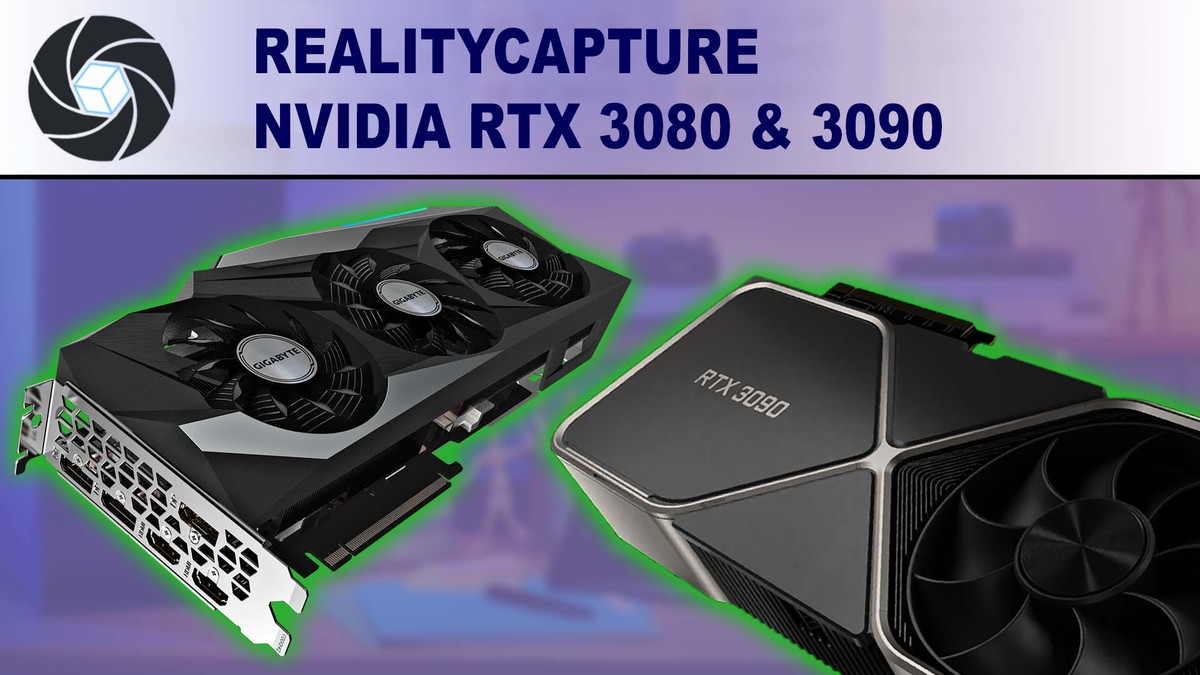Table of Contents
TL;DR: NVIDIA GeForce RTX 3080 & 3090 Performance in RealityCapture
NVIDIA's GeForce RTX 3080 turned in excellent performance in our benchmark tests, effectively matching or beating the much more expensive Titan RTX! The RTX 3090 was a hair faster yet, but for the additional $800 it costs the processing speed boost is negligible. Similar performance for less than half the price makes GeForce RTX 3080 the best video card for RealityCapture at this time.
Introduction
On September 1st, NVIDIA launched the new GeForce RTX 30 Series, touting major advancements in performance and efficiency. While gaming is almost always the media's focus during these kinds of launches, professional applications like RealityCapture should see some improvements as well.
If you want to see the full specs for the new GeForce RTX 3070, 3080, and 3090 cards, we recommend checking out NVIDIA's page for the new RTX 30 Series. But at a glance, here are what we consider to be the most important specs:
| VRAM | CUDA Cores | Boost Clock | Power | MSRP | |
|---|---|---|---|---|---|
| RTX 2070 Super | 8GB | 2,560 | 1.77 GHz | 215W | $499 |
| RTX 3070 | 8GB | 5,888 | 1.70 GHz | 220W | $499 |
| RTX 2080 Super | 8GB | 3,072 | 1.65 GHz | 250W | $699 |
| RTX 3080 | 10GB | 8,704 | 1.71 GHz | 320W | $699 |
| RTX 2080 Ti | 11GB | 4,352 | 1.55 GHz | 250W | $1,199 |
| RTX 3090 | 24GB | 10,496 | 1.73 GHz | 350W | $1,499 |
| Titan RTX | 24GB | 4,608 | 1.77 GHz | 280W | $2,499 |
While specs don't always line up with real-world performance, it is a great sign that NVIDIA has roughly doubled the number of CUDA cores compared to the GeForce RTX 20 Series cards at similar price points. At the top-end of the new line, NVIDIA appears to have also combined the roles of the previous-gen RTX 2080 Ti and Titan RTX into the new RTX 3090. It has as much VRAM as the Titan did, but for $1,000 less – putting it in the same ballpark as the 2080 Ti, but with more than double the memory and CUDA cores.
Puget Systems offers a range of powerful and reliable systems that are tailor-made for your unique workflow.
Test Setup
Listed below are the specifications of the system we used for our RealityCapture testing:
| Test Platform | |
| CPU | AMD TR 3970X 32 Core |
| CPU Cooler | Noctua NH-U14S TR4-SP3 |
| Motherboard | Gigabyte TRX40 AORUS PRO WIFI |
| RAM | 4x DDR4-2933 16GB (64GB total) |
| Video Card | NVIDIA GeForce RTX 3090 24GB NVIDIA GeForce RTX 3080 10GB NVIDIA Titan RTX 24GB NVIDIA GeForce RTX 2080 Ti 11GB NVIDIA GeForce RTX 2080 SUPER 8GB NVIDIA GeForce RTX 2070 SUPER 8GB NVIDIA GeForce RTX 2060 SUPER 8GB NVIDIA GeForce GTX 1080 Ti 11GB |
| Hard Drive | Samsung 960 Pro 1TB |
| Software | Windows 10 Pro 64-bit (Ver. 2004) RealityCapture 1.1.0.12901 |
*All the latest drivers, OS updates, BIOS, and firmware applied as of August 31st, 2020
Big thank you to Gigabyte for providing the GeForce RTX™ 3080 GAMING OC 10G sample used in our testing!
To test each video card, we used our in-house RealityCapture benchmark – both the standard and extended versions. Each was run twice per GPU, and the best results were included in the charts below. Here is some basic info about the image sets in these projects:
- Rock Model – 45 photos at 20 megapixels each
- School Map – 51 photos at 18 megapixels each
- School Model – 278 photos at 18 megapixels each
- Park Map – 758 photos at 18 megapixels each
We make these benchmarks publicly available under the Creative Commons BY-ND license, so if you use RealityCapture you can download them from our website and compare your system's performance with the results shown here.
Benchmark Results
Here are charts showing the performance of the new GeForce RTX 3080 and 3090 compared to the other video cards we tested:
Performance Analysis
The new GeForce RTX 3080 turned in excellent performance in our benchmark tests, effectively matching or beating the much more expensive Titan RTX! The RTX 3090 was a hair faster yet, but for the additional $800 it costs the processing speed boost is negligible.
Overall, the spread of cards isn't huge – especially when looking at the smaller image sets, which showed no more than 10% variance. However, if you are working with larger projects (multiple hundreds or thousands of images) then the differences between GPUs become more pronounced – and the new RTX 30 Series cards take a solid lead.
If you are curious about how the video card selection impacted different steps within RealityCapture, this table shows those full details:
Are the NVIDIA GeForce RTX 3080 & 3090 Good for RealityCapture?
Both the RTX 3080 and 3090 perform very well in this software! Their performance is almost identical, too, meaning that the GeForce RTX 3080 is the better choice for RealityCapture because it offers the same effective results for less than half the price.
As always, please keep in mind that these results are strictly for photogrammetry in RealityCapture. If you have performance concerns for other applications in your workflow, we highly recommend checking out our Hardware Articles (you can filter by "Video Card") for the latest information on how a wide range of programs perform with various GPUs, CPUs, and other hardware.
Puget Systems offers a range of powerful and reliable systems that are tailor-made for your unique workflow.

